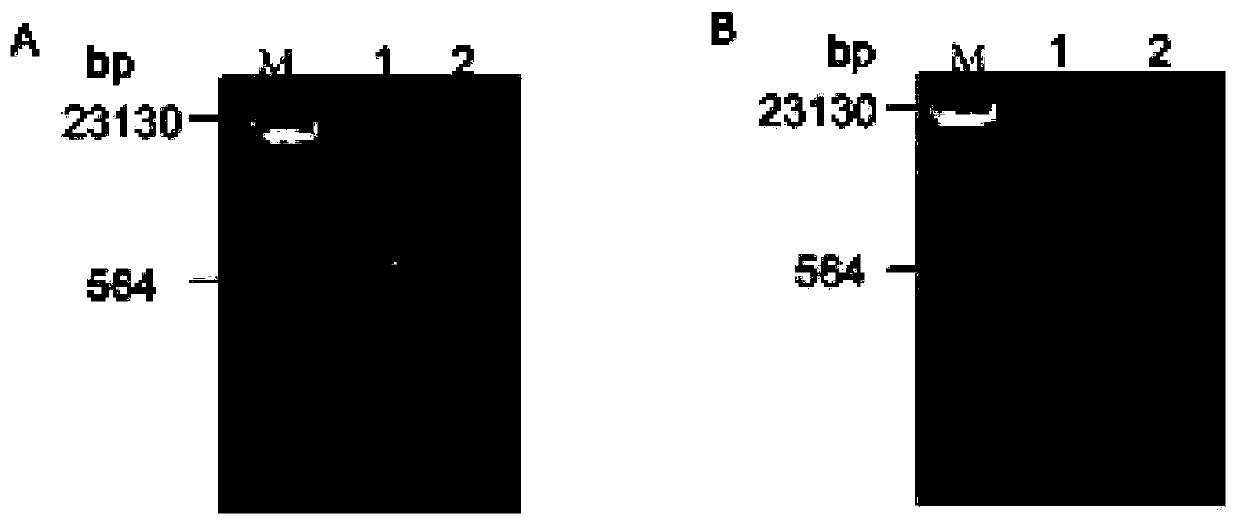Chloroplast DNA extracting method of sonneratia plant
A technology for chloroplasts and plant leaves is applied in the field of chloroplast DNA extraction of sea mulberry plants, and achieves the effects of short time consumption, avoiding RNA pollution and high purity
- Summary
- Abstract
- Description
- Claims
- Application Information
AI Technical Summary
Problems solved by technology
Method used
Image
Examples
Embodiment 1
[0054] The chloroplast separation and DNA extraction of embodiment 1 Sonneratia plant
[0055] The extraction and separation method of chloroplasts of the genus Sonsangia plants refers to the article published by Palmer et al. (Palmer J D, Stein DB. Conservation of chloroplast genome structure among vascular plants. CurrGenet, 1986, 10:823-833.), and improvements are made. All operating steps were carried out at 4°C unless otherwise specified, and all reagents and instruments needed to be pre-cooled in advance. The specific experimental methods and experimental results are as follows:
[0056] (1) Isolation and purification of chloroplasts of Sonangula genus
[0057] Collect 30 g of young, healthy and free of diseases and insect pests of Sonneratia sinensis young leaves that have not yet unfolded, and place them in a 4°C refrigerator for dark cultivation for 36 hours, so as to reduce the starch content in the leaves. Remove the veins of the leaves, weigh them, and cut them i...
Embodiment 2
[0060] Embodiment 2 Fluorescence microscope observation of the chloroplasts of the genus Sonangula
[0061] 1. Experimental method
[0062] The filtrate of the chloroplasts of the genus Sonanga chloroplast prepared in step (1) in Example 1 was centrifuged for 3 min under the centrifugal conditions of 100 × g, 200 × g, and 300 × g respectively, and the supernatant was transferred to a new 10 mL tube. Take 5uL of the precipitate and examine it under a fluorescent microscope (10× eyepiece, 40× objective lens).
[0063] 2. Experimental results
[0064] The results of fluorescent microscope examination of the chloroplasts of the genus Sonnensis under different centrifugation conditions are as follows: figure 1 As shown, it can be seen that under the fluorescence microscope, spherical and complete red chloroplast particles can be clearly seen, and their sizes are concentrated at about 200 μm. The number increased successively, among them, the number of chloroplasts of the genus S...
Embodiment 3
[0065] Example 3 Detection of the Integrity of Chloroplasts of Sangria genus Plants
[0066] 1. Experimental method
[0067] According to the results of fluorescence microscope observation in Example 2, take the chloroplasts of the genus Nutonia genus obtained under the centrifugation condition of 100 × g in Example 2, centrifuge the supernatant at 5000 × g for 5 min, discard the supernatant, leave the precipitate, and take 5uL of the precipitate in the fluorescence microscope. Microscopic examination was carried out under a microscope (10× eyepiece, 40× objective lens).
[0068] 2. Experimental results
[0069] The integrity detection results of the chloroplasts of the sangria genus obtained under the condition of 100×g centrifugation are as follows: figure 2 As shown, it can be seen that no nuclei were found, and a large number of high-purity chloroplasts of the Sonneratia plant were obtained, and the chloroplasts were all kept intact.
PUM
 Login to View More
Login to View More Abstract
Description
Claims
Application Information
 Login to View More
Login to View More - R&D
- Intellectual Property
- Life Sciences
- Materials
- Tech Scout
- Unparalleled Data Quality
- Higher Quality Content
- 60% Fewer Hallucinations
Browse by: Latest US Patents, China's latest patents, Technical Efficacy Thesaurus, Application Domain, Technology Topic, Popular Technical Reports.
© 2025 PatSnap. All rights reserved.Legal|Privacy policy|Modern Slavery Act Transparency Statement|Sitemap|About US| Contact US: help@patsnap.com



